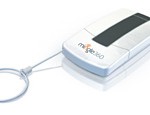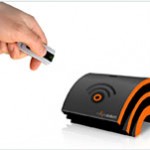
What could be more frustrating than having to deal with a pile of business cards and not even remembering who handed them to you? What about collecting tons of handouts from vendor expos and not being able to classify them in a timely manner? Mingle360’s emerging cutting edge technology for social networking, which is rapidly gaining grounds, is here to put an end to your frustration.

“The idea of electronic business cards has been sort of rattling around the intellectual space for a long, long, time. People don’t really love the typing; ‘I forgot why and where and what this person looks like’ kind of exercise,” Dan Coffing, CEO of Mingle360 told Ib’s Blog in an exclusive interview.
“We came up with this concept back in 2006. It was about the diversity of content that you can have online, and, how do we make it very, very easy for two people in a face-to-face meeting to say, ‘hey, come find out about me and later I will find out what me I am wishing to disclose. So that really opened up a lot of power for what this can do as a social tool.”
MingleStick is mostly used in trade-shows, conventions, and corporate events to allow people to interact and participate in a variety of things in a physical environment.
“Probably what makes us excited about this from an IT perspective is that it’s got those kinds of legs—that kind of versatility—because it’s just an ID,” Coffing said.
“You could use this for any number of other types of applications, just sort of, the person just enrolls the MingleStick to that functionality and suddenly the transaction is going to be supported in that fashion as well. There is an infrastructure to what we are doing that goes above and beyond an interesting trade show of business card application.”
The interview with Mr. Coffing continues below.
IBRAHIM DABO: Thanks to Mingle360’s use of technology, the era of business cards is slowly fading away, making networking easier than ever. How did your concept come about?
DAN COFFING: I think the fundamental thing was realizing the diversity of content that you can have about a person that’s stored online and looking for a very simple or even impulsive way to allow two people to actually connect and exchange references about content. We’d look at that and say, ‘hey, well, in this context it’s business card that I want to give you; in that context I don’t want you to have my cell phone [number]; in this context it’s a dating profile; over there it was social connection of some kind; here’s a resume,’ and on and on the list goes. So rather than having five, six, seven [or] ten business cards and making the other poor soul type all that information in, we thought there’d be a much better way for people to say, ‘hey, I’m interested. Let’s create the pathways to follow-up and in some sort of controlled disclosure process and to do that electronically rather than in paper.
IBRAHIM DABO: Let’s talk about the MingleStick. How does this device work?

DAN COFFING: In terms of [in] the user’s hand, it’s simple. It’s a one-click device. It passes a data reference between one MingleStick and the other. The data reference is hooked to an online profile gateway. This is what’s written into our patent-pending filings on that. So what it allows you to do is a person at an event—before an event or even after an event—they link their online profile with the MingleManager to their MingleStick and they go about the course of the evening, or the activity, and they’re handing out almost like tokens, or like a ‘check’ that says ‘hey, you can come back to my profile and I will then authorize you to see certain things.’ So the user experience at the event is very, very simple. They both press the button within a certain few seconds of each other and it will indicate a green success light, and when once that’s done, it indicates that the handshake has occurred and that both people now have the ability to go back and access whatever minimum amount of profile information that other users wanted to disclose to them. So, it moves from a live event—to a collection of cards and what you’re used to now—to returning back, plugging the device in and up will come the pictures and, depending on the level of disclosure, the different contact data points that person wanted to pass to the other party.
IBRAHIM DABO: How easy is it to use the online user-interface (MingleManager) for managing the uploaded MingleStick connections?
DAN COFFING: It’s very easy. You plug it in [and] it auto-runs. It takes you to the website. You do have a password login there, and then there is a pretty robust online outlook—sort of a centralized address book that organizes all the people. It flags them by the date; probably the event that you met them at [and] possibly the location, and you can group them by whatever might be the interest that you want to describe that particular affiliate group.
IBRAHIM DABO: Having brought social networking solutions to conventions and the like, how would you describe the level of success using this emerging cutting edge technology?
DAN COFFING: Well, I think, if you get the chance—and you probably did before the interview—to take a look at the videos on our site. The user testimonials have been very, very enthusiastic. I’ve joked before that it’s almost surprising how much late hate there is for paper business cards. Once you release a ubiquitous exchange technology into a meeting environment such as a trade show or convention—and it doesn’t have to be that; it could be a college event, or some other festival or training event or gathering—everybody gets the same connection technology. Then all of a sudden you will transform that room into a [group of] people who are very excited about the technology and use it as a source of social ingress or conversation starter. It’s been very, very well received from the user community.
IBRAHIM DABO: Your services seem to be geared primarily toward event organizers. What about individuals who might be interested in your product?
DAN COFFING: Your question is well placed. Yes, www.minglestick.com is the mechanism for individuals to purchase directly. The key thing about the technology is to have folks using the sticks around other users. So it makes a natural path for a user group—like a Chamber of Commerce—to both provide sticks to their members for free and also offer it for sale to guests. The more often a person participates in a ‘mingle-ized’ event, the more it will make sense to own their own.
IBRAHIM DABO: Privacy is always a major concern. How secured is personal information on MingleStick, and, in the event one loses this device, can the information be somehow retrieved?
DAN COFFING: That is the versatility of the architecture that we’ve designed and actually written into our IT business process…. Because it doesn’t actually contain your information, it just contains a data reference—and it’s a private data reference. It’s not like you can get my ID and go look it up some place, which you can’t. So I am handing out data references rather than actual information and that means I can: A) decide later what I want to disclose to you; and, B) if it fell into [the hands of] a third-party, there wouldn’t be a lot of use to it because it’s just data. The data doesn’t have any meaning outside of our system and if they don’t have your username and password, it’s just jibberish. So the physical security of the device is really geared around the device not containing any information at all but their information exists on the website.
IBRAHIM DABO: The MingleStation is also proving to be very essential to exhibitors and tradeshow organizers. What basically is the difference between the MingleStation and traditional lead retrieval systems?
DAN COFFING: First of all let me describe the difference between the MingleStick and the MingleStation.

The MingleStick is the user device—simple, one-click, solitary green light, ultra-easy connection mechanism. And so people can very quickly and spontaneously go [and say], ‘hey, it was great talking with you; I’d like to connect,’ and literally as fast as they can swap a physical card, they can use that MingleStick to make that connection. That’s one of the things that people enjoy so much about it. The upside continues on from there: so you end up with photo recognition of who is the person you met with, some customized profile information, an address book that keeps itself up-to-date, and you didn’t have to type anything in. That’s maybe the winner of everything else. It sort of does the whole transaction electronically the way it should have been from the start.
The MingleStation is a desktop, countertop unit that corresponds to the MingleStick and allows users to now not just in a mutual agreement with somebody else say, ‘hey, you and I should connect. We should talk, [and] we should exchange information.’ But now you are able to do that to an exhibitor, to a vendor, to somebody that is offering their services at a given environment. While the MingleStation is passive, it has higher capacity power. It has some extra software tools, and it also has the ability, when I log in, to see that particular vendor’s account in my MingleManager. They [the vendors] have the ability to disclose, [and/or] provide some online documents. Basically, it opens up a variety of green technology capabilities that I didn’t have to walk home with your very classic bag full of junk that sits in the corner until I finally throw it out three months later. It is that I can have all those documents, all the people that I flagged and say, ‘hey, I would like to know more about your company and your services,’ and be able to accumulate those tag requests, if you will, all electronically, all at the one-click of the button. That’s the difference between the MingleStation and the MingleStick.
Now what the MingleStation also adds over a traditional lead retrieval equipment is actually a two-way transaction. It is that I as the user, I’m walking home with a flag of the vendors I visited and vice versa for the vendors. The vendors are used to walking home with the name and the contact information but not used to having maybe a picture or a messaging mechanism or other social media or social graph types of orientation or potential data scenarios and things like that. So there is an upgrade for the vendor experience. For the user experience, right now you walk home… like I wonder who’s going to call me next. And if I didn’t write it down or do something to sort of memorize which booth I visited, [then] I’m at a loss. And so this sort of gives a much higher connection rate for the user experience and say, ‘there were seven booths that I visited today and I actually met with the sales person and I am going to have an electronic copy of that sales person’s name should I want to reach out or do more research or what have you.’

The third aspect to really understand is that the MingleStick-MingleStation system creates an environment. Environment is what really brings home the value stated because right now people have the bar scan, the RFID (radio frequency identification) or something like that. If it were a one-way client-to-vendor, I walk up, they try to get my information and it’s sort of just totally asymmetrical relationship. When you release MingleSticks in an environment and everybody is clicking around adherently—and we had one event with 720 users that passed over 30,000 business cards—that’s not a dynamic that you can create in any other way without ubiquitous technology like ours. Every person clicking amongst themselves and creating those connections creates a much higher activity level for the booth exhibitors and the sponsors and the people that were showering out $1,000 [or] $2,000 [or] $3,000 to operate and exist at that trade show environment. So we see a multi-faceted mechanism here of a better user experience, a better data-gathering mechanism and just a lot more connection activity going on on a show floor because of the ecosystem of the environment that the MingleStick-MingleStation technology creates.
IBRAHIM DABO: Impressive technology indeed. How cost effective are your products/services?
DAN COFFING: It will all depend on who the decision maker is on that point. We’ve seen environments where people were happy to pay $20 just not to have to type anything in from one event. So right away there is one value statement to it—being able to use this on a regular basis; this is real time saver. Fundamentally more important is: what is the value or the cost of that one, two, three, [or] five dozen connections you did make? And those sort of transactions—it’s networking that makes so much business transpire and there’s just something profoundly more valuable. When you and I met face-to-face there was a rapport that was established there that you can’t easily duplicate online. And so the fact that I am connecting with more people, engaged in more conversations and in turn from the exhibitor perspective [it is] the same. They are also connecting with more people and engaged in more conversations. This is incredibly important because you have to ask yourself why this person was attending the event. Simply put, it was to meet people. So if a person meets 30, [or] 40, [or] 50 percent more meeting of people, this is a very powerful statement for what the overall platform can do.
IBRAHIM DABO: Mingle360 has added integration with Facebook, LinkedIn, and Twitter, which could be seen as a significant milestone considering the fact that millions of people are using these Social Networking websites. Tell us a little more about this recent development and how it works.
DAN COFFING: That’s a logic question. The idea is that MingleManager is just a portal. So if part of what you want to communicate to a person is, ‘I live on Facebook’ or ‘I live on Hi5’ or LiveJournal or Crooks [and Liars] or any of these other sites, you can make it very easy for the person that you invited with MingleStick click to sort of come find the bulk of your contents. I think it’s probably a graduated process from, ‘hey, it was great to meet you’ to, ‘come, be my friend on Facebook.’ We want to make that process very, very smooth. We are just a portal allowing people to say, ‘come see me,’ whatever ‘me’ gets defined to be. The other aspect that is important is that you want to make the data movement as smooth as possible so that it’s easy to export down to Outlook or to CSP (Communicating Sequential Processes), or just synchronize down to your phone and things like that. And so those are some of the features that we look to establish. Regarding Facebook, Twitter, and LinkedIn, these social media tools are essentially miniature broadcast engines for me to advertise to my 300 friends and acquaintances the things and activities I’m doing during the day. It becomes a valuable tool for the growth of MingleManager and MingleStick to say, ‘hey, let’s make it easy for people to essentially navigate and participate with their Mingles within the sites that they are already familiar with.’
IBRAHIM DABO: In this technology-driven age, to what extent do you see your product revolutionizing the world of networking?

DAN COFFING: I think it underscores the importance of face-to-face connections and it says right now that there is a standing encumbrance to making that as smooth and as versatile as it could or should be. And so being able to, like I mentioned earlier, sort of raise the level of activity, raise the game, raise the flexibility of that connection from three or four steps down to one step, as simple with a one-click connection. It takes some of the friction out of a transaction. It takes a lot of the: ‘Now, I’m not going to be bothered with that,’ [or] ‘why the heck do I have this business card again,’ that sort of mentality that we sort of put up as a subconscious grid for the way we handle our connections. So is this the next Google [or] Facebook—I don’t know if it is necessary to speak in those terms. But every process and step that you can make in the way of making people get access to data and the object and things in their real world affairs and sort of handle that information from a very powerful data gathering, data mining, data processing tool, i.e., their computers or their mobile phones, every step that you could take along that way, and I think is an accelerant to furthering the relationships that people are having.
For more information, visit:
Company website: www.mingle360.com
Product website: www.minglestick.com
For contact details, call or email:
Sales: 703-425-0402 x111 / connect@mingle360.com
Investor Relations: 703-425-0402 x510
Also See:
· Exclusive Interview: SimulScribe CEO, James Siminoff, On Voicemail-To-Text Transcription
· Ross: We Need To View Security As An Investment In Our Mission’s Success
· Congressman Elijah Cummings Emphasizes The Need To Know Technology
· IT Security Automation Conference Highlights New Security Strategies
· About Ib’s Blog

Great interview, Ibrahim. Very informative. I’m kicking myself for not purchasing the mingle stick at the Sucess in the City holiday mixer earlier this month.